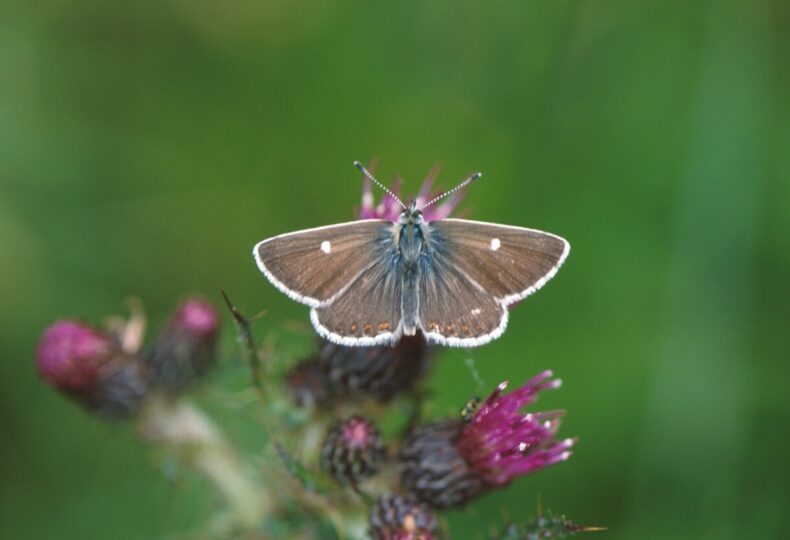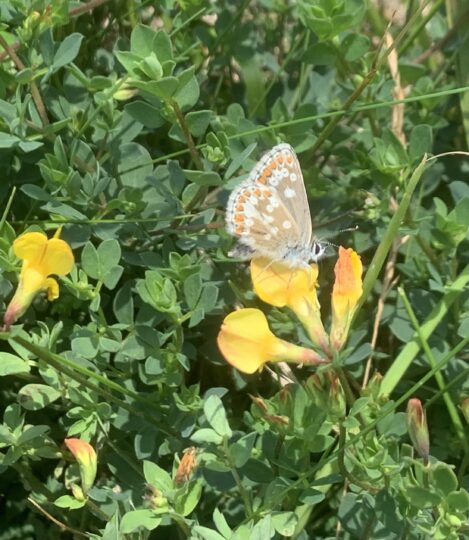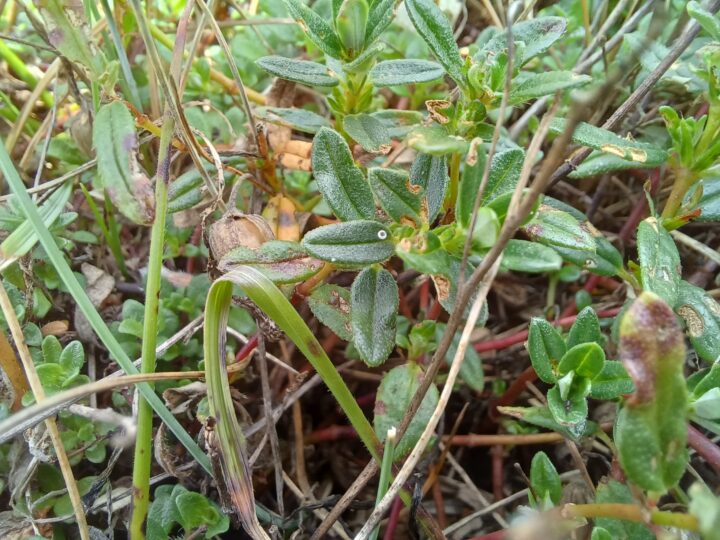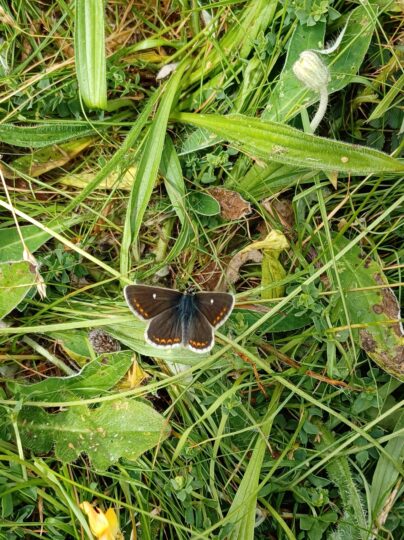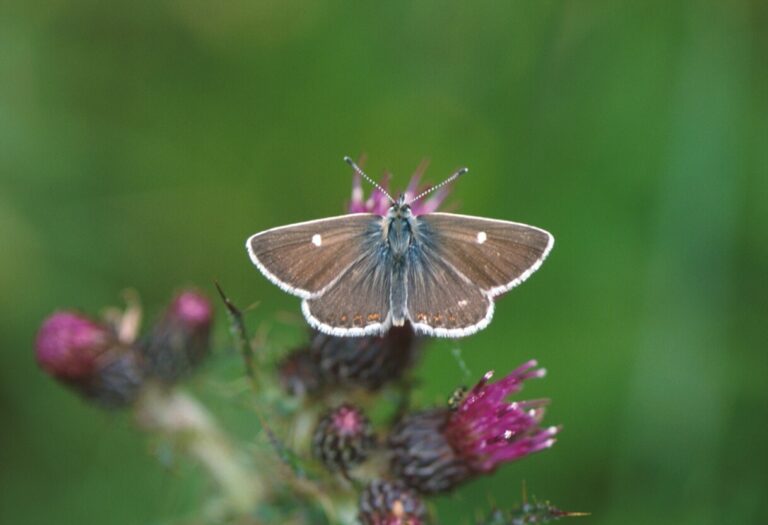
Key facts
- Gaelic name: Argas donn tuathach
- Wingspan: 25 – 31mm
- Distribution in UK: Scotland and Northern England
- When to see: June – early September
- Status: Scottish Biodiversity List
- Species on the Edge areas: Solway; East Coast
Species information
How to identify
The northern brown argus butterfly is dark chocolaty brown in colour with orange crescents towards the outer edges of the wings. The male has less or no orange crescents on the upperwing. This small butterfly has a silvery appearance as it flies low over the ground making it hard to follow. The Scottish species can be distinguished from its southern counterpart by the white forewing spot. The underwing pattern of the female is very similar to the underwing of the common blue female and can cause confusion.
Lifecycle
The species is single brooded with adults being recorded from early June through until the end of August, with numbers peaking from late June to early August. However, the flight period can vary considerably between years and between regions. The eggs are laid singly on the upperside of common rock-rose leaves, where they are highly visible and easily counted. Females select plants that have fleshy leaves, rich in nitrogen, and typically growing in sheltered situations. They lay most frequently in medium (6-10 cm) and taller (>10 cm) swards. The young larvae feed on the underside of the leaves, leaving the upper surface intact. They hibernate while quite small at the base of the foodplant or on the ground. The larvae start basking in early spring before recommencing feeding. They are sometimes attended by ants. The larvae pupate in late May.
Distribution
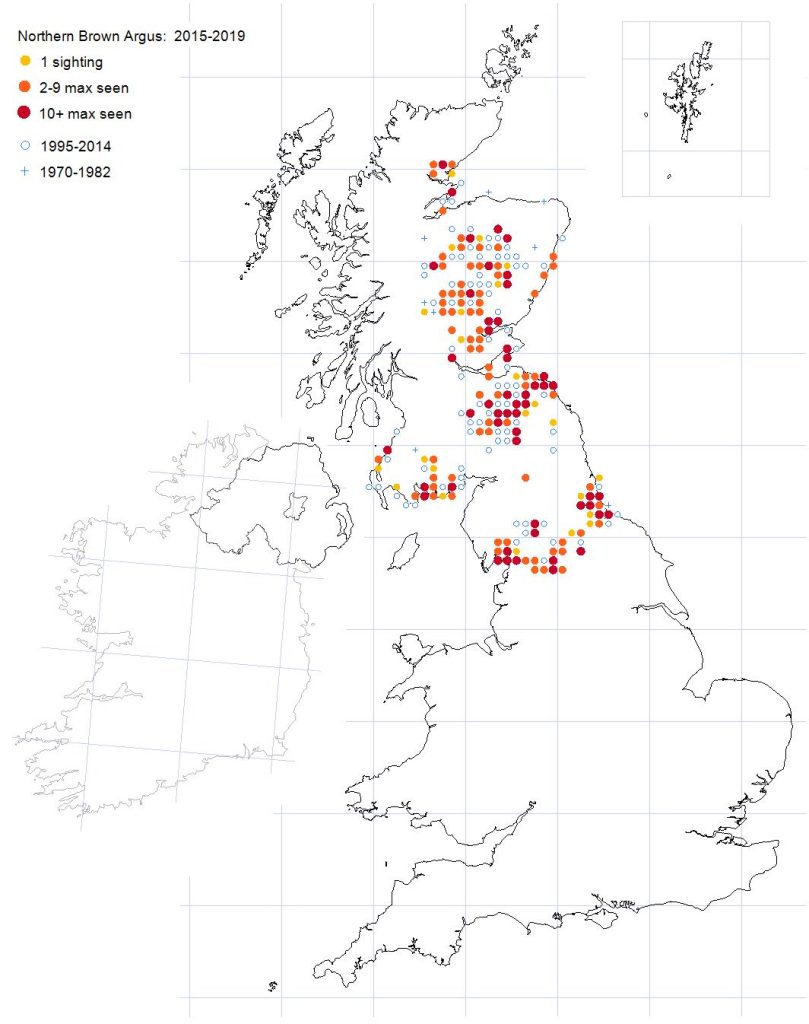
Northern brown argus distribution map. Credit: Butterfly Conservation www.butterfly-conservation.org/butterflies/northern-brown-argus
Habitat and feeding
Conservation status
- Section 41 species of principal importance under the NERC act in England
- Scottish Biodiversity List
- GB Red List (2022): Vulnerable
- Butterfly Conservation: High
- European status: Not threatened
- Protected under Schedule 5 of the 1981 Wildlife and Countryside Act (for sale only)
Threats
What Species on the Edge is doing
-
Increased monitoring and surveying, to better understand the needs of all stage of the lifecycle
-
Raising awareness among landowners and the public of the butterfly
-
Working to ensure that woodland schemes are not planted on traditional northern brown argus sites
-
Working with landowners to better improve connectivity and quality of habitat
Habitat management for northern brown argus
The overall aim is to maintain a varied sward with a large proportion of Common Rock-rose areas in the medium (6-10cm) and tall (>10cm) categories. Site size is important – a minimum of 0.2ha is recommended to support a population.
How to survey and monitor
Northern Brown Argus is best surveyed either by searching for adults or eggs, either intact or hatched. Egg surveys have the advantage that they are not weather dependent. Surveys to locate Common Rock-rose are also useful in helping to identify suitable breeding habitat that can subsequently be checked for occupancy by looking for adults or eggs. Monitoring is best undertaken either by adult timed counts or single species transects, or timed egg counts. The latter is best undertaken over set short time periods e.g. 15-20 minutes of continual searching, before moving on toanother location. Habitat condition surveys can help identify the need for habitat management.
Grazing
The most suitable grazing regimes have yet to be determined, but light grazing levels of up to 0.2 LU/ha/year are recommended. Sites managed by more intensive grazing regimes may still support the butterfly, but at a low population density. Proven regimes include winter or late summer and autumn grazing (e.g. 4 sheep or 0.5 cattle per hectare for four months). Alternatively, lighter year round grazing can be used, but stocking levels should be reduced to no more than 0.1 LU/ha between April and July. However, on more fragile hill systems, and on sites maintained primarily by rabbits, this may represent overgrazing. Care should also be taken to re-introducing grazing gradually on neglected sites.
Mowing
Mowing is always a poor alternative to grazing. However, where grazing is impractical, a single annual cut in the autumn (September) can maintain suitable habitat. Grassland should be mown on rotation, leaving some areas uncut each year. Some sward variation can be achieved by adjusting the height of the mower.
Scrub control
Periodic scrub removal may be necessary at some sites although light, well-spaced scrub is often beneficial to provide shelter, especially on more exposed sites. Scrub can be cut on a rotation of 10-15 years to maintain existing levels of cover, and where scrub reduction is necessary the stumps should be treated with herbicide to prevent regrowth. On neglected sites, concentrate on controlling scrub lying within mosaics of grassland and scrub, where the foodplant is still present, in preference to dense scrub.
